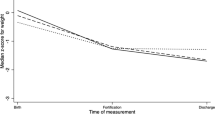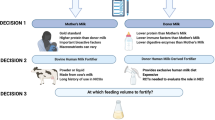Abstract
Objective
To investigate differences in hypoglycemia and extended feed prescriptions among premature infants provided bovine-derived human milk fortifiers (Bov-fort) with mother’s milk or formula vs human milk-derived human milk fortifiers (HM-fort) with mother’s milk or donor human milk.
Study design
This was a retrospective chart review (n = 98). Infants receiving HM-fort were matched with infants receiving Bov-fort. Blood glucose values and feed orders were retrieved from the electronic medical record.
Results
Prevalence of ever having blood glucose <60 mg/dL was 39.1% in the HM-fort group vs. 23.9% in the Bov-fort group (p = 0.09). Blood glucose ≤45 mg/dL occurred in 17.4% of HM-fort vs 4.3% in Bov-fort (p = 0.07). Feeds were extended for any reason in 55% of HM-fort vs. 20% of Bov-fort (p < 0.01). Feed extension due to hypoglycemia occurred in 24% of HM-fort vs. 0% of Bov-fort (p < 0.01).
Conclusion
Predominately HM-based feeds are associated with feed extension due to hypoglycemia. Prospective research is warranted to elucidate underlying mechanisms.
This is a preview of subscription content, access via your institution
Access options
Subscribe to this journal
Receive 12 print issues and online access
$259.00 per year
only $21.58 per issue
Buy this article
- Purchase on Springer Link
- Instant access to full article PDF
Prices may be subject to local taxes which are calculated during checkout

Similar content being viewed by others
Data availability
The datasets generated and/or analyzed during the current study are available from the corresponding author upon reasonable request.
References
Bhatia J. Human milk and the premature infant. Ann Nutr Metab. 2013;62:8–14.
Morales Y, Schanler RJ. Human milk and clinical outcomes in VLBW infants: how compelling is the evidence of benefit? Semin Perinatol. 2007;31:83–8.
Sullivan S, Schanler RJ, Kim JH, Patel AL, Trawoger R, Kiechl-Kohlendorfer U, et al. An exclusively human milk-based diet is associated with a lower rate of necrotizing enterocolitis than a diet of human milk and bovine milk-based products. J Pediatr. 2010;156:562–7.e1.
Cristofalo EA, Schanler RJ, Blanco CL, Sullivan S, Trawoeger R, Kiechl-Kohlendorfer U, et al. Randomized trial of exclusive human milk versus preterm formula diets in extremely premature infants. J Pediatr. 2013;163:1592–5.e1.
Wickland J, Wade C, Micetic B, Meredith K, Martin G. A retrospective analysis of the effects of an exclusively human milk protein diet on neonatal feeding tolerance. Am J Perinatol. 2020;39:995–1000.
Assad M, Elliott MJ, Abraham JH. Decreased cost and improved feeding tolerance in VLBW infants fed an exclusive human milk diet. J Perinatol. 2016;36:216–20.
O’Connor DL, Kiss A, Tomlinson C, Bando N, Bayliss A, Campbell DM, et al. Nutrient enrichment of human milk with human and bovine milk-based fortifiers for infants born weighing <1250 g: a randomized clinical trial. Am J Clin Nutr. 2018;108:108–16.
Quigley M, Embleton ND, McGuire W. Formula versus donor breast milk for feeding preterm or low birth weight infants. Cochrane Database Syst Rev. 2019;7:CD002971.
Sharma A, Davis A, Shekhawat PS. Hypoglycemia in the preterm neonate: etiopathogenesis, diagnosis, management and long-term outcomes. Transl Pediatr. 2017;6:335–48.
Staffler A, Klemme M, Mola-Schenzle E, Mittal R, Schulze A, Flemmer AW. Very low birth weight preterm infants are at risk for hypoglycemia once on total enteral nutrition. J Matern Fetal Neonatal Med. 2013;26:1337–41.
Amendoeira S, McNair C, Saini J, Habib S. Glucose homeostasis and the neonatal brain: a sweet relationship. Neonatal Netw. 2020;39:137–46.
Barone G, Maggio L, Saracino A, Perri A, Romagnoli C, Zecca E. How to feed small for gestational age newborns. Ital J Pediatr. 2013;39:28.
Davis TA, Fiorotto ML, Suryawan A. Bolus vs. continuous feeding to optimize anabolism in neonates. Curr Opin Clin Nutr Metab Care. 2015;18:102–8.
Bozzetti V, Paterlini G, De Lorenzo P, Gazzolo D, Valsecchi MG, Tagliabue PE. Impact of continuous vs bolus feeding on splanchnic perfusion in very low birth weight infants: a randomized trial. J Pediatr. 2016;176:86–92.e2.
Wang Y, Zhu W, Luo BR. Continuous feeding versus intermittent bolus feeding for premature infants with low birth weight: a meta-analysis of randomized controlled trials. Eur J Clin Nutr. 2020;74:775–83.
Brooks C, Vickers AM, Aryal S. Comparison of lipid and calorie loss from donor human milk among 3 methods of simulated gavage feeding: one-hour, 2-hour, and intermittent gravity feedings. Adv Neonatal Care. 2013;13:131–8.
Castro M, Asbury M, Shama S, Stone D, Yoon EW, O’Connor DL, et al. Energy and fat intake for preterm infants fed donor milk is significantly impacted by enteral feeding method. JPEN J Parenter Enter Nutr. 2019;43:162–5.
Rogers SP, Hicks PD, Hamzo M, Veit LE, Abrams SA. Continuous feedings of fortified human milk lead to nutrient losses of fat, calcium and phosphorous. Nutrients 2010;2:230–40.
Enfamil Human Milk Fortifer Powder: Mead Johnson & Company, LLC; Available from: https://www.hcp.meadjohnson.com/s/product/a4R4J000000PpQiUAK/enfamil-human-milk-fortifier-powder.
Liquid Protein Fortifier: Abbot Nutrition; Available from: https://abbottnutrition.com/liquid-protein-fortifier.
MCT oil Nestle Health Science Available from: https://www.nestlenutritionstore.com/mct-oilr.html.
Thompson-Branch A, Havranek T. Neonatal hypoglycemia. Pediatr Rev. 2017;38:147–57.
Abramowski A, Ward R, Hamdan AH. Neonatal hypoglycemia. StatPearls. Treasure Island (FL, 2022).
Mank E, van Toledo L, Heijboer AC, van den Akker CHP, van Goudoever JB. Insulin concentration in human milk in the first ten days postpartum: course and associated factors. J Pediatr Gastroenterol Nutr. 2021;73:e115–e9.
Rodel RL, Farabi SS, Hirsch NM, Rolloff KP, McNair B, Hernandez TL, et al. Human milk imparts higher insulin concentration in infants born to women with type 2 diabetes mellitus. J Matern Fetal Neonatal Med. 2022;35:7676–84.
Funding
This project was supported by the University of Rochester CTSA award number UL1 TR002001 from the National Center for Advancing Translational Sciences of the National Institutes of Health. The content is solely the responsibility of the authors and does not necessarily represent the official views of the National Institutes of Health.
Author information
Authors and Affiliations
Contributions
The following authors contributed significantly to the study conception and design: DA, CD, JM, BY; data collection: DA, BY; analysis and interpretation of results: DA, HW, BY; and draft manuscript preparation: DA, HW, BY. All authors reviewed the results and approved the final version of the manuscript.
Corresponding author
Ethics declarations
COMPETING INTERESTS
The authors declare no competing interests.
Ethics
This retrospective chart review was granted exempt status by the University of Rochester Institutional Review Board (study ID: STUDY00006172).
Additional information
Publisher’s note Springer Nature remains neutral with regard to jurisdictional claims in published maps and institutional affiliations.
Rights and permissions
Springer Nature or its licensor (e.g. a society or other partner) holds exclusive rights to this article under a publishing agreement with the author(s) or other rightsholder(s); author self-archiving of the accepted manuscript version of this article is solely governed by the terms of such publishing agreement and applicable law.
About this article
Cite this article
Ackley, D., Wang, H., D’Angio, C.T. et al. Human milk-derived fortifiers are linked with feed extension due to Hypoglycemia in infants <1250 g or <30 weeks: a matched retrospective chart review. J Perinatol 43, 624–628 (2023). https://doi.org/10.1038/s41372-023-01654-z
Received:
Revised:
Accepted:
Published:
Issue Date:
DOI: https://doi.org/10.1038/s41372-023-01654-z



